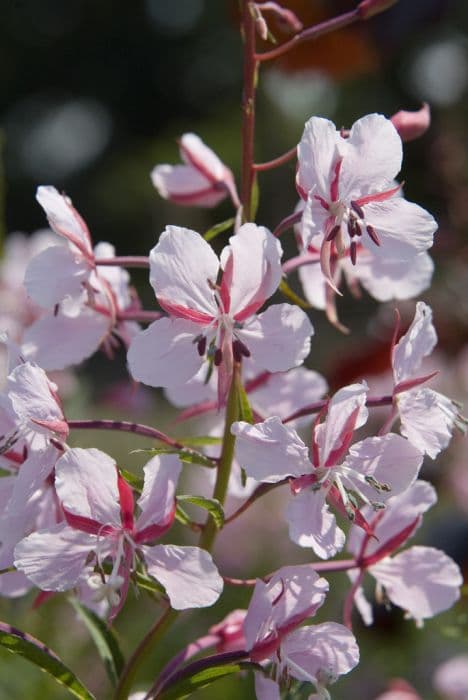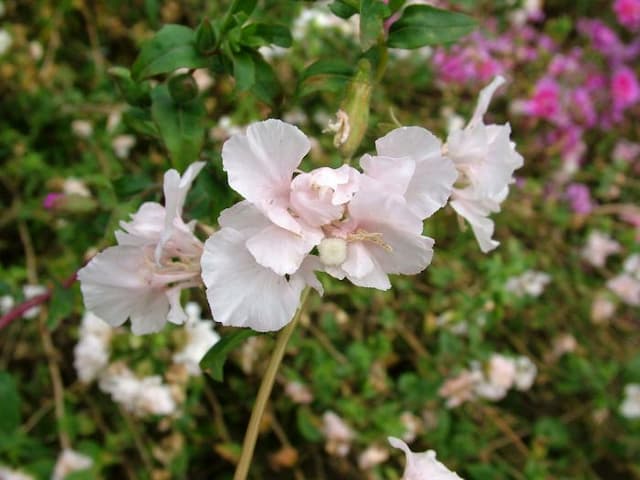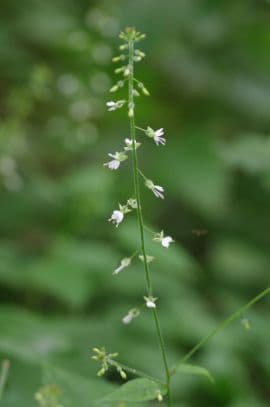Fuchsia Fuchsia 'Dark Eyes' (d)

ABOUT
Fuchsia 'Dark Eyes' is a captivating ornamental plant adorned with distinctive and attractive flowers. The blooms are particularly eye-catching, featuring a unique two-tone color palette. The outer petals, known as the sepals, are typically a vibrant, purplish-pink hue, elegantly long, and slightly recurving. Complementing the sepals, the inner petals form a gracefully contrasting deep purple to almost black corolla that is bell-shaped and pendulous. Furthermore, the stamens typically protrude from the corolla, adding an additional touch of visual interest with their delicate appearance and lighter tones that stand out against the dark background of the inner petals. The flowers dangle gracefully from the branches, resembling exquisite earrings and providing a continuous display of color throughout its blooming season. The foliage of Fuchsia 'Dark Eyes' serves as a lush backdrop for these dramatic flowers. The leaves are typically a deep green, with a slight sheen to them. They are oval-shaped with lightly serrated edges, providing a texture contrast to the smooth, flowing lines of the flowers. The overall presentation of Fuchsia 'Dark Eyes' is one of elegant contrast, with the dark blooms standing out against the fresh greenery. This plant is often used in hanging baskets and container gardens due to its trailing habit and prominent, showy flowers, making it a popular choice for adding visual interest to patios, balconies, and garden spaces.
About this plant
 Names
NamesFamily
Onagraceae
Synonyms
Fuchsia 'Dark Eyes', Lady's Eardrops, Hardy Fuchsia, Hummingbird Fuchsia, Bellflower
Common names
Fuchsia 'Dark Eyes'
 Toxicity
ToxicityTo humans
Fuchsia 'Dark Eyes', commonly known as Fuchsia, is not considered toxic to humans. In general, fuchsias are regarded as safe plants and there are no well-known toxic effects from ingesting parts of this plant. However, individual allergies and sensitivities can vary, and it is always prudent to exercise caution and avoid eating ornamental plants.
To pets
Fuchsia 'Dark Eyes', commonly referred to as Fuchsia, is also not known to be toxic to pets such as dogs and cats. The ASPCA lists fuchsias as non-toxic to both dogs and cats. Therefore, ingestion of this plant should not cause any significant symptoms of poisoning in pets. Nevertheless, as with any non-food plant, consumption in large quantities could potentially lead to mild gastrointestinal upset due to the ingestion of non-digestible matter.
 Characteristics
CharacteristicsLife cycle
Perennials
Foliage type
Deciduous
Color of leaves
Green
Flower color
Mixed
Height
1-2 feet (30-60 cm)
Spread
1-2 feet (30-60 cm)
Plant type
Shrub
Hardiness zones
9
Native area
Central America South America
Benefits
 General Benefits
General Benefits- Attractive Flowers: Produces striking, pendulous flowers with a unique color combination that adds visual interest to gardens.
- Long Blooming Period: Known for its long flowering season, which can provide color from spring to fall in the right conditions.
- Habitat for Pollinators: Flowers attract hummingbirds, butterflies, and other pollinators, supporting local biodiversity.
- Versatile In Landscaping: Can be used in a variety of garden designs, including containers, hanging baskets, and borders.
- Shade Tolerance: Tolerant of partial shade, making it suitable for darker areas of a garden where other plants may struggle.
- Easy Propagation: Can be easily propagated through cuttings, allowing gardeners to produce more plants at little cost.
 Medical Properties
Medical PropertiesThis plant is not used for medical purposes.
 Air-purifying Qualities
Air-purifying QualitiesThis plant is not specifically known for air purifying qualities.
 Other Uses
Other Uses- Fuchsia 'Dark Eyes' can be used as a natural dye for fabrics, giving them a subtle, unique hue derived from the flowers.
- The plant's berries are edible and can be made into jellies or jams, providing a tangy flavor that is uncommon in most fruit preserves.
- Create miniature fairy gardens incorporating Fuchsia 'Dark Eyes' due to their enchanting bell-shaped flowers and vivid color contrasts.
- Fuchsia flowers can serve as a colorful garnish for salads, desserts, and cocktails, adding a touch of elegance to the presentation.
- Utilize the plant's branches and flowers for artistic purposes, such as making bookmarks or pressed flower arrangements.
- The distinctive flowers of Fuchsia 'Dark Eyes' can be used as natural confetti for weddings or celebrations.
- Grow Fuchsia 'Dark Eyes' in hanging baskets to create living curtains for privacy on balconies or in garden spaces.
- Fuchsia petals can be steeped in water to craft a floral-infused rinse for a unique hair care routine.
- The plant can be trained to grow as a bonsai, providing an unusual and rewarding challenge for gardening enthusiasts.
- Fuchsia 'Dark Eyes' can be incorporated into educational activities to teach children about pollination and plant growth.
Interesting Facts
 Feng Shui
Feng ShuiThe Fuchsia is not used in Feng Shui practice.
 Zodiac Sign Compitability
Zodiac Sign CompitabilityThe Fuchsia is not used in astrology practice.
 Plant Symbolism
Plant Symbolism- Confiding Love: Fuchsia 'Dark Eyes' often represents confiding love, suggesting a deep connection and trust between individuals.
- Good Taste: With its elegant blossoms, the Fuchsia symbolizes good taste and sophistication in the art of living.
- Ardent Affection: The vibrant colors and shape of Fuchsia flowers can signify ardent affection and deep emotional intensity.
- Amiability: These plants are said to embody amiability, depicting grace and a welcoming demeanor.
 Water
WaterFor Fuchsia 'Dark Eyes', commonly known as Hardy Fuchsia or Lady's Eardrops, it's important to maintain consistently moist soil. Water the plant thoroughly when the top inch of the soil feels dry to the touch, which might be once or twice a week, depending on environmental conditions. Avoid letting the soil dry out completely, as this can stress the plant and lead to wilting. When watering, use enough water so that it runs out of the drainage holes in the bottom of the pot, ensuring the entire root ball is moistened. In hot weather, check the soil moisture more frequently, as evaporation can dry out the soil quicker. For potted plants, this might be around 16-32 ounces of water per week, but outdoor garden plants will require more, potentially up to 1-2 gallons depending on size and climate conditions.
 Light
LightFuchsia 'Dark Eyes' thrives in partial shade to filtered sunlight. It prefers bright conditions without being exposed directly to harsh midday sun, which can scorch its delicate leaves. The ideal spot for the plant would be one where it receives morning sunlight and afternoon shade, or dappled light throughout the day. East or north-facing spots, especially in hotter climates, are best for providing these light conditions.
 Temperature
TemperatureFuchsia 'Dark Eyes' prefers a temperate climate and does not tolerate extreme heat well. The ideal temperature range for this plant is between 60°F and 75°F. It can survive in temperatures as low as 40°F but should be protected from frost. Conversely, temperatures above 80°F can stress the plant and should be avoided if possible.
 Pruning
PruningPruning Hardy Fuchsia is essential for maintaining its shape and encouraging bushier growth. Prune in late winter or early spring before new growth begins, removing any dead or damaged wood and shortening long branches. Pruning can be done again lightly after the first bloom period to stimulate a second flush of flowers. It's also beneficial to deadhead spent blooms throughout the flowering season to promote continued blooming.
 Cleaning
CleaningAs needed
 Soil
SoilFuchsia 'Dark Eyes' thrives in well-draining soil rich in organic matter with a slightly acidic to neutral pH between 6.0 and 7.0. A mix of peat moss, loam, and sand or perlite is ideal to ensure proper drainage and aeration.
 Repotting
RepottingFuchsias, including the 'Dark Eyes' variety, should be repotted annually in the spring to refresh the soil and accommodate root growth.
 Humidity & Misting
Humidity & MistingFuchsia 'Dark Eyes' prefers high humidity levels, ideally between 60% to 70%, to maintain healthy growth and lush foliage.
 Suitable locations
Suitable locationsIndoor
Place in bright, indirect light and maintain high humidity.
Outdoor
Hang in partial shade, shelter from wind, and keep soil moist.
Hardiness zone
10-11 USDA
 Life cycle
Life cycleThe life of a Fuchsia 'Dark Eyes', commonly known as Fuchsia, begins with seed germination, where a consistent moist and warm environment induces the emergence of radicles and plumules. This is followed by the seedling stage, during which the young Fuchsia develops true leaves and a root system capable of sustaining further growth. As it enters the vegetative stage, the Fuchsia experiences rapid growth, producing characteristic green foliage and begins to form a woody structure. The plant then reaches the flowering stage, typically in spring or summer, displaying its pendulous, two-toned blooms with a deep purple corolla and red sepals appealing to pollinators. After pollination, the Fuchsia produces small, oval-shaped fruit containing seeds, thereby completing the reproductive cycle. In colder climates, the Fuchsia enters a period of dormancy during the winter, reducing its metabolic activity until favorable conditions for growth return.
 Propogation
PropogationPropogation time
Spring-Early Summer
The Fuchsia 'Dark Eyes', commonly referred to as the fuchsia, is most successfully propagated through softwood cuttings. The ideal time for taking cuttings to propagate fuchsia is late spring to early summer, when the plant is actively growing and the stems are green and flexible. To propagate by cuttings, one should select a healthy stem, cut a length of about 2 to 4 inches (5 to 10 centimeters), and make sure the cutting has a few leaves. The bottom set of leaves should be removed, and the cut end may be dipped in rooting hormone powder to encourage root development. The cutting should then be placed in a moist potting mix and kept under high humidity and indirect light until roots have formed, which typically takes about 3 to 4 weeks. It's important to maintain the moisture of the potting mix without making it waterlogged. After roots have established, the new fuchsia plant can be transplanted to a larger pot or into the garden to continue its growth.









